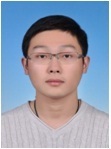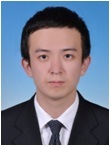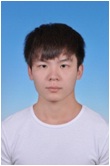|
| | | Yulin Shi(史玉琳),Postdoc |  | | Yulin Shi, obtained his BS and MS degrees in chemical technology at XinJang University. In April 2012, he received his Ph.D in fine chemicals at Dalian University of Technology. From April 2012 to August 2013, he worked for CNOOC Tianjin Chemical Research & Design Institute as a chemical engineer. He entered into School of Chemical Engineering, ShiHeZi University as a research staff in September 2013. Up to now, he has published 4 papers in material chemical engineering related journals, such as Carbohydrate Polymers and so on. His research area contains: (1) Stimuli-reponsive polymers: synthesis, properties and applications; (2) Preparation of Ni/Zn/Si composite material and its application in synthetic polymers hydro-upgrading catalyst. |
| | | Xiaogang Gu(顾小刚),Postdoc |  | | GuXiaogang, postdoctor, Ph.D. in environmental science and engineering, graduated from East China University of Science and Technology in June 2014. I am focusing on the remediation of organic contaminants in groundwater by means of advanced oxidation processes (AOPs), and my interests include development of novel activation technologies of common oxidants, investigation of redox processes during oxidants activation, and the interaction between AOPs and chemical constituents in subsurface environment. |
| | | WeihuaWang(王伟华),Ph. D. Candidate |  | | Wang Weihua, Ph. D student, graduated from Qingdao University of Science and Technology in June 2009 and the second year of doctor degree in East China University of Science and Technology now. My main subject is synthesis of multi-functional spherical polyelectrolyte brushes(SPBs) and characterization by small angle x-ray scattering(SAXS). SPBs consist of polystyrene(PS) cores onto which polyacrylic acid(PAA) are densely grafted which can be used as nanoreactors of synthesis of nano-mental particles, magnetic particles and adsorption of proteins. SAXS can be applied to characterize (1)particle size, shape and distribution; (2)particle dispersion; (3)particle volume fraction and specific surface area; (4)interfacestructure and the degree of phase separation between the particles and medium; (5) the interaction between particles. SAXS is proved to be a result-statistical, test-rapid, sample-nondestructive and preparation-simple method compared with other nano-scaled analysis methods, such as SEM, TEM, AFM. |
| | | Jing Huang(黄婧),Ph. D. Candidate | 
| | Huangjing, Ph.D. candidate with major in chemical technology, acquired bachelor degree in East China University Of Since And Technology in 2009. My subject is about the adjustment and improvement of the rheology of complex fluid, including crude oil and coal water slurry (CWS), through amphiphilic comb-like copolymer. Some of the major problems in oil processing, transformation and storage are wax deposition on oil pipe walls and the high viscosity, which causes flow problems and costs plenty of energy. The synthesized oil-soluble comb-like copolymer would interact with the asphaltene and wax in crude oil, resulting a reduction in wax precipitation and enhanced flowability of oil. Meanwhile, a series of synthesized water-soluble copolymers are applied in CWS as well. As fuel of oil alternatives, CWS is required to have a solid content as high as posible and a good flowability. Thus the settling and high viscosity of the dispersion are big challenges. The copolymer dispersants can adsorb on the surface of coal particles, which provides electrostatiic repulsion and steric hindrance among coal particles, improve the rheology and stability the suspension, and enable a more concentrated CWS. |
| | | Mingwei Wang(王铭纬),Ph. D. Candidate |  | | Wang Mingwei, Chemical Technology, Doctor Candidate. I graduated from Henan University in 2010 and now study in East China University of Science and Technology. My research subject is Novel Nanoparticle based on Cyclodextrin by Flash Nanoprecipitation in Multi-inlet Vortex Mixer. Due to its ultra-small size, nanoparticle can pass through the organization clearance and be absorbed by the cells as a drug carrier, which shows great potential and is widely researched. The size of nanoparticles should be larger than 70 nm to prevent their rapid clearance because of renal filtration, but smaller than 300 nm to escape capture by phagocytic cells located in reticuloendothelial system. However, all of the traditional methods have some problems in size distribution. A novel approach to generate nanoparticles is Flash NanoPrecipitation (FNP), a scalable process with controlled size distribution and a high drug-loading rate (DLR), in which nanoparticles are precipitated from polymer chains in solution as a result of displacing a solvent with a non-solvent. |
| | | Yu Cang(仓钰),Ph. D. Candidate |  | | Cang Yu, Ph. D student, graduated from East China University of Science and Technology in July 2010 and is having further study for a doctor’s degree. My research is aimed at preparation of multiresponse spherical polyelectrolyte brushes and hydrogel which was linked by nanoparticals. Hydrogels are three—dimensional hydrophilic polymer networks used in many areas,such as soil amelioration, medicine, hygiene, biomedical applications and so on.For practical utilities, most hydrogels must be able to operate against an external load, and thus hydrogels with high mechanical strength are required.However, the industrial and biomedical applications of ordinary hydrogels made from synthetic sources are strongly limited by their poor mechanical properties. My research is aimed at systhetizedhydrogels that were crosslinked by nanoparticals and thermosensitive polymers were initiated by photo and heat. The characteristics of transparency, swelling, rheological properties and elongation were improved. We also use domestic JKR intelligent instrument which was set up by our group to research the structure and energy of hydrogels. |
| | | Xiaochi Liu(刘小驰),Ph. D. Candidate |  | | Xiaochi Liu, the major of material chemical engineering, M-D postgraduate, graduated from the major of the chemical engineering and technology in East China University of Science and Technology, is studying in the chemical engineering Institute of East China University of Science and Technology. My research’s aimed at preparation and application of inorganic-organic hybrid polymer materials and my topic is the synthesis of Fluorescent spherical polyelectrolyte brush (SPB) and PVK-PAA brushes with optical activity. Quantum dots, which is an organic material that fluoresce under UV irradiation, can be inserted into polystyrene core to make SPB labeled. This kind of carrier is available for protein encoding procedure and medical identification. Poly(N-vinylcarbazole) (PVK) has optical activity and it’s usually used as LCD material. PVK-PAA brush, which consists of a PVK core and a shell of PAA chains, has potential applications in new type of optical nanodevices. |
| | | Weina Wang(王维娜),Ph. D. Candidate |  | | Wang Weina,My thesis was “The study of rheology and adhesive mechanism on hydrogels and the applications in biochemistry”. Hydrogels are hydrophilic polymers that are crosslinked to form insoluble, but water-swellable networks. They are with high water content, flexibility in tailor-made physiochemical properties, and closely resemblance to human tissue. Mussel adhesive proteins are the natural products from marine organisms. They are friendly to the environment and have the advantages of wide application、high curing rate,corrosion resisting ability、high strength,good biocompatibility, thus this neotype bio-adhesives has great value in biomedical aspects. However, only 1g mucous with super strength can be extracted from 10000 mussels. This process is really complicated and costly and can’t meet the demand in reality, therefore the bionic polymer of mussel emerge as the times require. In this paper, we will base on the different cross-linking mechanisms to explore the adhesive DOPA material and compare the differences between its derivants, control the flowing and adhesive property to study the inner adhesive mechanism. |
| | | Yiming Wang(王义明),Ph. D. Candidate | 
| | Yiming Wang, a first year Ph.D candidate. Establishment of chitosan-based macromolecular system and their applications in pharmaceutical field were his PhD research project. Chitosan received tremendous attentions due to its excellent biocompatible property. Duringhis PhD period, chitosan would be employed to establish a serious of functional macromolecular system, such as smart polymeric micelle, stimuli-responsive polymeric hydrogels and spatial directional self-assemble aggregates. Their applications in pharmaceutical field would also be investigated. This research will extend the applications of chitosan. |
| | | Haoya Han(韩浩亚),Ph. D. Candidate |  | | Han Haoya, Ph. D student, graduated from East China University of Science and Technology in July 2012 and is having further study for a doctor’s degree. This research is mainly about the synthesis of spherical polyelectrolyte brushes (SPB) and their hybridization with organic/inorganic particles, and the characterization methods, especially SAXS, used in this system. Organic/inorganic particles, like magnetite nanoparticles, can be embedded in core. The obtained MSPB are narrowly dispersed, pH sensitive, rapidly responsive to magnetic fields and redispersible. SPB can also be used as nano-reactors and carriers for the formation of silver nanoparticles. Silver nanoparticles were obtained with a narrow particle size distribution and good catalytic activity for the reduction of 4-nitrophenol by NaBH4. SPB can adsorb large amount of biomacromolecules, resulted from electrostatic attraction, hydrogen bond, hydrophobic association, and Van der Waals forces between the polyelectrolyte chains grafted on SPB and biomacromolecules. Small angle X-ray scanning, a characterization method usually used in sub microstructure, can be well used for the characterization of SPB system. |
| | | Lao Li(厉涛),Ph. D. Candidate | 
| | Li Tao, received bachelor degree in the major of Polymer Science and Engineering from Chemistry and Chemical Engineering Institute of Shaanxi University of Science &Technology. I study in East China University of Science and Technology for doctor’s degree. In order to investigate the mechanism of the effect of comb-type copolymer on the flow ability of crude oil. Maleic aggregation. anhydride-α-octadecene derivatives with different pendants and different length of the bridging chains were designed and synthesized successfully to study structure of copolymer effect with oils. Combining molecular simulation, wax crystal and asphaltene have been found two main effects in the oil. Thus, through changing different properties of wax and asphaltene model oil, study the mechanism of control the wax crystal and asphaltene |
| | | Yuchuan Tian(田雨川),Ph. D. Candidate |  | | YuchuanTian, the major of chemical technology, M-D postgraduate, graduated from ECUST in 2013, is now major in the synthesis of functional nano-sized spherical brushes composite and its characterization through SAXS. Layer-by-Layer (LBL) deposition is based on alternate deposition of two different kinds of polyelectrolyte. Through LBL deposition, we can immobilize different kinds of nano-materials onto the SPB, such as the enzyme, metal nanoparticles, polyelectrolyte etc. And use SAXS to characterize the SPB composite. Meanwhile, inverse emulsion polymerization although indicates a novel way to synthesis a new kind of SPB. |
| | | Ang Li(李昂),Ph. D. Candidate |  | | My name is Li Ang, from Qin huangdao, Hebei Province. I acquired my bachelor degree from East China University of Science and Technology in June. 2013. My major is light chemical engineering. My topic is mussel inspired hyaluronic acid-protein coacervate and the study of its adhesive property. Common blue mussel is a sessile organism that has unique ability to attach to a wide array of organic and inorganic marine surfaces using its holdfast structures. 3, 4-Dihydroxyphenylanine (DOPA)-containing proteins from byssal plaque are responsible for mussel adhesion. In this paper, DOPA was successfully grafted to hyaluronic acid polymer chain, and the grafting ratio was about 16%. HA-DOPA was characterized by UV-Vis, FTIR and 1HNMR. Then, BSA and HA-DOPA were stirred together under certain salt concentrations to form the adhesive coacervate by adjusting pH . Thecoacervate showed good adhesive ability under day conditions according to lap shear testing results. Rheology tests were done to characterize the storage modulus(G’), loss modulus(G’’) and other properties. |
| | | Zhenyu Yuan(袁镇豫), Ph. D. Candidate |  | | Yuan Zhenyu, Ph. D student, graduated from East China University of Science and Technology in July 2010 and is having further study for a doctor’s degree. It is well known that AB diblock copolymers can spontaneously self-assemble in solvents, such as micelle, worm or vesicle. Usually such aqueous nano-structures have been formed by hydrophilic–hydrophobic block copolymers. In contrast, double-hydrophilic or double-hydrophobic block co-polymers emerge as a new class of block co-polymers with unique and tunable properties to construct ordered supermolecules via self-assembly with various conditions. My research is about the self-assemble of double-hydrophilic or double-hydrophobic block co-polymers. |
| | | Xiaohan Wang(王晓晗),Ph. D. Candidate |  | | Wang Xiaohan, Ph. D student, graduated from East China University of Science and Technology in July 2014 and is having further study for a doctor’s degree. This research is mainly about the synthesis of inorganic-organic nanoparticles with different hydrophobicity and charge density via atom transfer radical polymerization(ATRP) and its application in protein separation, antibacterial and drug delivery. Tuning of the functional groups in nanoparticles can provide nanoparticles with different biological properties, including cellular uptakes, adsorption by proteins and antibiosis. Furthermore, targeted delivery and effective separation could be achieved by means of the supramagnetic property of Fe3O4 nanoparticles, which provide great potential in experimental investigation as well as industrial application. |
| | | Yunwei Wang(王云伟), Ph. D. Candidate | 
| | Wang Yunwei, Ph. D candidate, graduated from Jiang Nan University in July 2014 and is havingfurther study for a doctor’s degree in ECUST. Polyelectrolyte brushes are assembly polymer structures which are formed by linear polyelectrolyte chains attached to spheric particles.Consist of a solid poly(styrene) core and a shell of poly(acrylic acid) (PAA). Polyelectrolyte chains can not only enhance the stability of the system, but also can response uniquely to the environmental conditions, including pH and added salt concentration. |
| | | Zhenchuan Yu(于振川),Master Candidate |  | | Yu Zhenchuan, the major of material chemical engineering, master postgraduate, graduated from the major of the chemical engineering and technology in Liaocheng University, is studying in the chemical engineering Institute of East China University of Science and Technology. The main research is to build polymer ultra-fine materials which is based on supercritical CO2 solvent. Supercritical CO2 is readily available, inexpensive, nontoxic, nonflammable, and can be easily recaptured and recycled after use. Such advantages combined with unique properties of SCFs such as adjustable solvent power and enhanced mass transfer characteristics have offered the opportunity to replace conventional organic solvents in a variety of applications in chemical reactions and ultra-fine materials synthesis. |
| | | Hang Liu(刘行),Master of Eng. Candidate |  | | Hang Liu, Master of Engineering Candidate, graduated from Cheng Du University of Science and Technology in June 2012, received bachelor’s degree in Chemistry. The main research directions are Composite Materials of Sulfonic Acid-Functionalized Polymers and Carbon Nanotubes as Carbon-Based Solid Acids for Transesterification and Esterification。A series of polymer-carbon nanotubes composite materials (CNT-P-SO3H) were prepared by covalent grafting of multi-walled carbon nanotubes (CNT) with sulfonic acid-functionalized polymers (P-SO3H) including poly(3-vinyl-1-sulfonic acid imidazolium chloride)-grafted CNT (CNT-PVSAIC), poly(4-vinyl-1-sulfonic acid pyridinium chloride)-grafted CNT (CNT-PVSAPC), and poly(4-styrenesulfonic acid)-grafted CNT (CNT-PSSA). The resulting CNT-P-SO3H materials exhibit catalytic activity as carbon-based solid acids in the liquid phase transesterification of triglycerides with methanol and esterification of oleic acid with methanol, which are typical model reactions for biodiesel production. The catalytic performances of CNT-P-SO3H catalyst are attributed to a combination of mesoporous structure together with well extended P-SO3H coating over the outer surface of the CNT, providing the formation of dense but uniform surface distribution of active sites. Moreover, the surface exposure of active sites can facilitate the access of reactants and promote the migration of reagents away from the catalyst. |
| | | Kai Huang(黄铠), Master Candidate |  | | Huang Kai,Master student, graduated from Zhejiang University of Technology in July 2013 and is studying for a master’s degree. This research is mainly about the hydrogel based on the inclusion of cyclodextrin. As is known to all, so far almostly all kinds of the cyclodextrinhydrogels are prepared by steps of organic synthesis in laboratory. My project aims at preparing cyclodextrinhydrogels with less steps so that increases the yield and conversion rate. In the project, γ-CD is used as the connection of two polymer chains for its relatively huger inclusive volume. In this way the Achilles’ heel is broken through and the practicability of cyclodextrinhydrogels is dramatically developed |
| | | Mengxue Wang(王梦雪),Master Candidate |  | | Wang Mengxue, undergraduate student, graduated from East China University of Science and Technology in July 2013 and is having further study for a master degree. This research is mainly about hydrogel , the secret ion of marine mussels with high adhesive property , could be adsorbed to the surfaces of inorganic and organic materials. Further studies show that it derivatives containing catechol groups also possess the strong adhesive property as DOPA shown. The main studying is its apply in hydrogel. |
| | | Kui Meng(孟奎),Master Candidate |  | | MengKui, master candidate of 2013, graduated from the major of the chemical engineering and technology in Wuhan University of Technology, is studying in the chemical engineering institute of East China University of Science and technology. In this semester, I have done some major experiments of our group : synthesis of HMEM, PS-PAA SPB, MAC and SMANS . The next period I will continue to study the SMANS and we hope it can be applied in industry as soon as possible. |
| | | Xiaoyan Hou(候晓燕),Master Candidate | 
| | Hou Xiaoyan, Master student, majoring in material chemical engineering, graduated from Hebei University of Science and Technology in July 2013 and is having further study for a master’s degree in East China University of Science and Technology. My research is mainly about the organic chemistry reaction in IL/scCO2。Supercritical carbon dioxide and ionic liquid can form a unique system which shows unique characteristics: supercritical carbon dioxide can dissolve in ionic liquid, but the ionic liquid does not dissolve in supercritical carbon dioxide. Supercritical carbon dioxide in the ionic liquid can reduce the viscosity of the ionic liquid, which is conducive to promote the mass transfer process. In IL/scCO2 system, metal catalyst will be fixed in the ionic liquid, so the catalytic reaction conducts in a homogeneous system. After the reaction, we can separate the product and realize the recovery of catalyst by supercritical carbon dioxide extraction. |
| | | Hanqing Zhao(赵汉青),Master Candidate |  | | Zhao Hanqing, Postgraduate student, graduated from TianJin University of Science and Technology in June 2012, and now is having further study for a master’s degree. My research direction is effect of comb-type copolymers grafted with nitrogenous heterocyclic compounds on flow ability of waxy oils. Nitrogenous heterocyclic compounds are provided with excellent thermal stability, chemical stability, good polarity, and fluorescence properties. Therefore, study on the synthesis of comb-type copolymers grafted with nitrogenous heterocyclic compounds and the effect on waxy oils can be conducted. 2-Aminobenzimidazole including various functional groups and aromatic nucleus, is able to form weak hydrogen bond, strong PI...PI accumulation effect and C-H...PI force, which have influence on crystallization of colloid and asphaltene in crude oils. Graft polymer can also form coordination effect with metal ions in crude oils and influence oil flow performance. Containing double bond and aromatic ring, 2-aminobenzimidazole exhibited good fluorescence properties. These properties can be used to research the functional mechanism of polymer in the oil. |
| | | Xue Qin(秦雪),Master Candidate |  | | Qin Xue, Master, graduate from the East China University of Technology in July 2013, and now is having further study for a master degree. Mainly research directions is the preparation of spherical polyelectrolyte brushes and their interaction with the protein. In this experiment, HEAA is the branch of SPB, being grafted from PS core. Their interaction with the protein also explore in this experiment. |
| | | Jie Deng(邓洁),Master Candidate |  | | Jie Deng, Master student, graduated from East China University of Science and Technology in July 2008 and is having further study for a master’s degree. The research background is about the phase pattern of various of nanometer spherical polyelectrolyte brushes (SPB). With the influence of space resistance effect and electrostatic repulsion, the side chains of nanometer spherical polyelectrolyte brushes extend. These bring SPB masses of particular and unique features , such as excellent stability as well as surface wetting ability, leading to extensive application. Compare SPB with diverse side chain, we can ameliorate theory of SPB, serve as reference for application. |
| | | Decheng Gai(盖德成),Master Candidate |  | | GAI Decheng, Master student, graduated from Yantai University in July 2013 and is having further study for a master’s degree. This research is mainly about the synthesis of comb polymers and their improved effects on rheological properties of crude oil. Since the electrostatic intermolecular interactions, hydrogen bonding, hydrophobic association, van der Waals interactions, etc., the comb polymer may be adsorbed at the surface or embedded in paraffin wax, and by eutectic mechanism to prevent spontaneous crystallization into stable large mesh crystals from precipitation, thus changing the rheological properties of crude oil. Simulate and reconcile model oil of different paraffin based on existing oil components and study the influence of comb polymer on the rheological properties of the model oil, dead oil and live oil under high pressure conditions. Meanwhile, We will further study pressure and high-pressure CO2 of their impacts on the inversion point of crude oil emulsion, the stability and interfacial properties. Through the study of the mechanism between the heavy components in oil and the comb polymer then according to synthetic experiments and the test results, we try to find several comb polymer additives that can significantly reduce the flow properties of heavy oil under pressure conditions. New additives have potential applications for heavy oil recovery, delivery, storage in energy-saving technology and for the subsequent deep processing in operation aspect. |
| | | Xianjing Jia(贾先靖),Master Candidate |  | | Jia Xianjing , Master student, graduated from An Hui university of science and technology in July 2012 and is having further study for a master’s degree in East china university of science and technology. This research is mainly about the synthesis of mesoporous silica nanoparticles (MSNs) and its application. Good control of the morphology, particle size, uniformity and dispersity of mesoporous silica nanaparticles is of increasing importance to their use in catalyst, adsorption, polymer filler, optical devices, bio-imaging,drug-delivery,and biomedical applications. The functionalized modification of mesoporous silica endow the hybrid materials with colorful properties. |
| | | Jun Ma(马俊),Master Candidate |  | | Jun Ma , Master student, graduated from NanJing University of Technology in July 2014 and is having further study for a master’s degree in East China University of Science and Technology. My research is mainly about photo-responsive polymer vesicles based on the coumarin radical group. Photosensitive groups present different structures in different light conditions. The preparation of the photo-responsive polymer vesicles could be divided into two parts: the first was the synthesis of coumarin-MMA monomer and the other was the synthesis of amphiphilic block polymer by ATRP. |
| | | Miaomiao Liu(刘苗苗),Master Candidate | 
| | Liu Miaomiao, master, graduated from Central South University in July 2010 and is having further study for a mater’s degree. This research is mainly about stabilization of β-lactoglobulin Fibrils. Under acidic conditions, β‑lactoglobulin would form mature, multistranded, twisted fibrils with continued heating, which called β‑lactoglobulin Fibrils. It’s rigidity, in combination with the significant contour length, makes these fibrils ideal for the production of percolated networks for a wide range of applications, such as scaffolds and drug delivery devices. However, increased temperature, denaturants, certain aromatic compounds, pH, surface-induced fragmentation, pressure, or interactions with charged polymers can break down these amyloid fibrils, limiting their ability to be used in a wide range of applications. Several studies have investigated electrostatic interactions imparted additional charge to the fibril surface, ultimately preventing aggregation and increasing stability. In order to determine if addition of polymeric components to the exterior surface of fibrils would reduce aggregation and degradation of fibrils formed in acidic conditions during an increase of the pH, we will investigate the interaction of some polymers with β-lactoglobulin fibrils at different pH values. |
| | | Zheqi Shen(沈哲琦),Master Candidate |  | | Shen zheqi, master candidate, graduated from Shanghai University of Electric Power in July 2014 and is having further study for a master’s degree at East China University of Science and Technology. My main research is the effect of carbon dioxide on the Nano-sized Spherical Brushes. Poly(N,N-dimethylaminoethyl methacrylate) (PDMAEMA) in water can react with carbon dioxide (CO2), I will try to graft PDMAEMA on the spherical polystyrene (PS) core with photoinitiator, which can be used as an nanoreactors of synthesis of nano-mental particles. It has potential applied value. |
| | | Zhiqiang Qiu(邱志强),Master Candidate | 
| | Qiu Zhiqiang, Master student, graduated from Nanjing University of Science and Technology in July 2014 and is pursuing advanced studies in ECUST. The research is mainly about selective catalysis of Heck coupling reaction in water by nanometal particles loaded in cyclodextrin polyelectrolyte brush and its mechanism. Firstly, the cyclodextrin polyelectrolyte brush nanoreactor is prepared by styrene and cyclodextrin to the core and shell of spherical polyelectrolyte brush, respectively. Secondly, the nanometal catalyst is prepared by the in situ reduction reaction. |
| | | Jianjun Wang(王建军),Master of Eng. Candidate |  | | Wang Jianjun,Master student,graduated from East China University of Science and Technology in July 2014 and is having further study for a master’s degree. I have excellent personal learning ability. During my postgraduate I've joined in many social activities as well as experimental tasks. I’ve participated in the research group of Dr Li and I am co-trained by SINAP with research topic relating to biomedical polymer material. I'm confident to adopt in new research environment and proceed to gain my Master degree, next stage of great importance in my life. |
| | | Jiahua Wang(王家华),Master Candidate | 
| | Wang Jiahua, master candidate, graduated from the major of the chemical engineering and technology in Northwestern University, is studying in the chemical engineering institute of East China University of Science and technology. This research is mainly about hydrogel, the secret ion of marine mussels with high adhesive property , could be adsorbed to the surfaces of inorganic and organic materials. Further studies show that it derivatives containing catechol groups also possess the strong adhesive property as DOPA shown. The main studying is its apply in hydrogel. |
|

